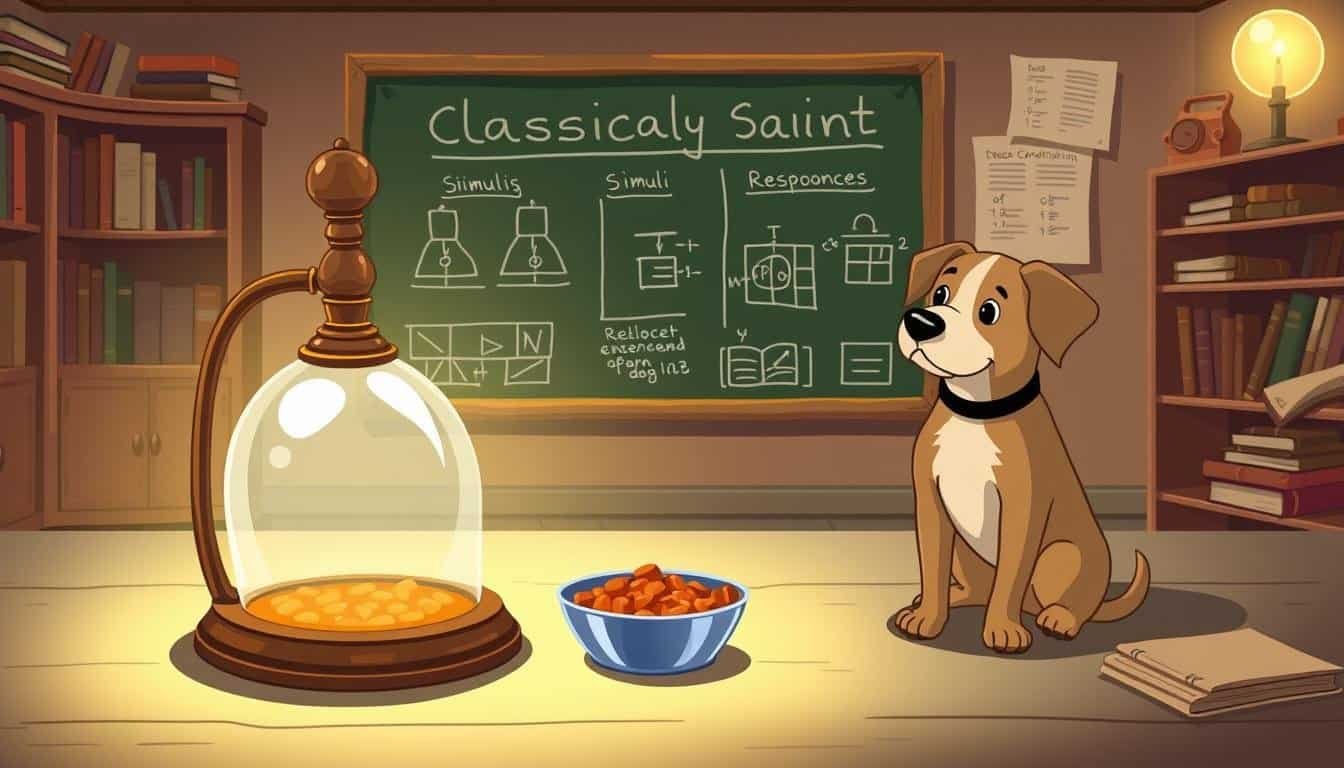Understanding Classical Conditioning (Pavlov) Basics
Ever wondered why hearing a bell makes you think of food, even if there’s no food around? This isn’t just a weird quirk. It’s a key part of classical conditioning. Ivan Pavlov discovered this in the late 1800s. His work changed how we see learning and behavior.
Pavlov’s famous dog experiments showed how our minds link certain sounds or sights with actions. This process, called classical conditioning, shapes our behaviors. It affects many areas, from psychology to marketing.
Key Takeaways
- Classical Conditioning (Pavlov) involves forming associations between stimuli to elicit responses.
- Ivan Pavlov’s experiments with dogs established the groundwork for behaviorism in psychology.
- Understanding key terms like unconditioned stimulus and conditioned response is essential to grasp classical conditioning.
- Pavlov’s discoveries remain influential in modern psychological therapies and learning theories.
- Critiques of Pavlov’s work highlight the complexities of human behavior beyond simple stimulus-response associations.
Introduction to Classical Conditioning
Classical conditioning is a key idea in behavioral psychology. It shows how we learn to link a neutral thing with something that makes us react. This learning happens without us even thinking about it, changing our actions through what happens around us.
In the late 1800s, Ivan Pavlov made classical conditioning famous with his dog experiments. He found that dogs could link a sound, like a bell, with food. After many times together, the dogs would start to drool at just the sound, showing how strong these links can be.
This theory helps us understand many behaviors. It shows how we can pick up habits or fears through repeated experiences. Knowing about classical conditioning helps us see why some behaviors stick with us. It also shows how we can help change these behaviors in learning or therapy settings.
History of Classical Conditioning
Ivan Pavlov started classical conditioning in the late 1800s. He was studying dogs’ digestion. This led to a big discovery in psychology that changed how we think about learning.
Discovery by Ivan Pavlov
In the 1890s, Ivan Pavlov noticed something interesting. Dogs were salivating not just at the sight of food but also at the sight of the people who fed them. This made him think about how stimuli and responses are connected. His work, including “The Work of the Digestive Glands,” showed how behavior is linked to physical processes.
Pavlov’s Dog Experiment
Pavlov’s Dog Experiment is a key part of his research. He used a bell as a neutral stimulus before giving food to the dogs. At first, the dogs didn’t react to the bell. But after many times together, they started salivating when they heard the bell. This showed how a neutral stimulus could become a conditioned one, changing psychology history.
Key Terms in Classical Conditioning
Classical conditioning relies on key terms to explain how we learn. These terms help us understand how responses change over time through association.
Unconditioned Stimulus (UCS)
An unconditioned stimulus is a stimulus that naturally causes a response without learning. In Pavlov’s work, food was the unconditioned stimulus. It made dogs salivate naturally.
Conditioned Stimulus (CS)
A conditioned stimulus is a neutral stimulus that, after linking with an unconditioned stimulus, causes a conditioned response. In Pavlov’s study, the bell became a conditioned stimulus. It made dogs salivate after being paired with food.
Unconditioned Response (UCR)
The unconditioned response is the automatic reaction to an unconditioned stimulus. In Pavlov’s study, dogs salivated when given food. This showed a natural response that happened without learning.
Conditioned Response (CR)
A conditioned response is the learned behavior to a conditioned stimulus after linking with an unconditioned stimulus. Dogs learned to salivate at the sound of the bell. This was because they associated the bell with food.
| Term | Definition | Example |
|---|---|---|
| Unconditioned Stimulus (UCS) | Stimulus that naturally elicits a response | Food presented to dogs |
| Conditioned Stimulus (CS) | Previously neutral stimulus that elicits a conditioned response after association | Bell sound paired with food |
| Unconditioned Response (UCR) | Automatic reaction to an unconditioned stimulus | Salivation in response to food |
| Conditioned Response (CR) | Learned reaction to a conditioned stimulus | Salivation in response to the bell |
Classical Conditioning (Pavlov) Mechanism
Ivan Pavlov discovered how a neutral stimulus can turn into a conditioned one by linking it with an unconditioned stimulus. This shows how linking stimuli can create new responses. For example, Pavlov’s dogs learned to salivate when they heard a tone because it meant food was coming.
Classical conditioning can happen with just one pairing, but more pairings make the link stronger. There are different ways to condition, like forward conditioning, where the conditioned stimulus comes before the unconditioned one. This is the most effective method.
Other ways include delay and trace conditioning, which focus on the timing of the stimuli. Simultaneous and backward conditioning show different effects on learning. Backward conditioning can even make responses weaker, showing how complex classical conditioning can be.
Researchers like Pavlov have shown how classical conditioning affects behavior and other processes. It’s not just for animals; it helps us understand human behavior, appetite, and even how drugs work. This shows its wide impact in science and everyday life.
| Conditioning Type | Description | Impact on Learning |
|---|---|---|
| Forward Conditioning | Conditioned stimulus precedes unconditioned stimulus | Most effective learning method |
| Delay Conditioning | Conditioned stimulus overlaps with unconditioned stimulus presentation | Promotes strong stimulus associations |
| Simultaneous Conditioning | Conditioned stimulus and unconditioned stimulus are presented together | Less effective but can establish associations |
| Backward Conditioning | Conditioned stimulus follows unconditioned stimulus | May lead to inhibitory conditioned responses |
| Second-Order Conditioning | Association formed between a neutral stimulus and a conditioned stimulus | Deepens complexity of learned responses |
Phases of Classical Conditioning
The process of classical conditioning has three main phases. Each phase is crucial for linking stimuli with responses. These phases show how we learn behaviors from our environment.
Before Conditioning
At first, the environment has a neutral stimulus that doesn’t cause a response. Then, an unconditioned stimulus makes an unconditioned response happen automatically. This response is natural and doesn’t need thinking, preparing the ground for learning.
During Conditioning
In the during conditioning phase, stimulus pairing happens. The neutral stimulus links with the unconditioned stimulus over time. This association learning makes the neutral stimulus start to cause a response, turning it into a conditioned stimulus.
After Conditioning
After conditioning, the change is full. The neutral stimulus now triggers a conditioned response on its own. This shows how we can learn new behaviors through classical conditioning.
| Phase | Description | Key Terms |
|---|---|---|
| Before Conditioning | Neutral stimulus present; unconditioned stimulus elicits an unconditioned response. | Neutral Stimuli, Unconditioned Stimulus (UCS), Unconditioned Response (UCR) |
| During Conditioning | Neutral stimulus paired with the unconditioned stimulus leading to a learned association. | Stimulus Pairing, Association Learning |
| After Conditioning | Conditioned stimulus elicits conditioned response indicative of learned behavior. | Conditioned Response (CR), Learned Behavior |
Pavlov’s Experiment and Its Findings
In the 1890s, Pavlov started an experiment that changed how we see learning. He paired a bell’s sound with food for dogs, using a clever technique. The dogs were in special places to avoid distractions. He recorded their salivation on a drum to measure their reactions.
Methodology of Pavlov’s Experiment
Pavlov paired a bell with food to teach the dogs. Over time, the dogs learned to salivate when they heard the bell. This showed how they linked the bell with food.
Results and Observations
The dogs learned to salivate at the sound of the bell, showing a strong link between the sound and their response. This behavior was seen many times. Pavlov also found that the response could come back after a break, called “spontaneous recovery.” He also saw that the dogs could react to sounds similar to the bell, called generalization.
| Aspect | Details |
|---|---|
| Research Period | 1890s |
| Subject | Dogs |
| Methodology | Sound (bell) paired with food |
| Key Findings | Conditioned response (salivation) to bell |
| Other Observations | Spontaneous recovery, generalization |
| Amplications | Behaviorism, therapy techniques |
Principles of Classical Conditioning
Classical conditioning has key principles that explain how behaviors start and change. These include acquisition, extinction, spontaneous recovery, generalization, and discrimination. Each principle is important for learning and how we respond to things.
Acquisition
Acquisition is when an organism starts to learn the link between a conditioned stimulus (CS) and an unconditioned stimulus (UCS). By repeating these pairings, behaviors get stronger. This helps in learning well. As the organism learns, it starts to connect the stimuli with certain outcomes.
Extinction
Extinction happens when the conditioned stimulus comes without the unconditioned stimulus. This makes the conditioned response disappear. It shows that keeping up the reinforcement is key to keeping learned behaviors. Without reinforcement, responses slowly fade away.
Spontaneous Recovery
Spontaneous recovery is a key part of classical conditioning. After a break from the conditioned stimulus, the extinguished response might come back. This shows that extinction doesn’t completely remove the learned knowledge. Under certain conditions, the old associations can return.
Generalization and Discrimination
Stimulus generalization lets a conditioned response happen with similar stimuli. This shows how learned behaviors can adapt in different situations. On the other hand, stimulus discrimination is key for making responses more precise. It helps an organism know which stimulus to react to. This shows how complex learned behaviors can be.
Behavioral Psychology and Classical Conditioning
Classical conditioning has greatly influenced behaviorism. It shows that behaviors come from learned links. This idea helps in changing behaviors in therapy and schools. It focuses on what we can see, not just our thoughts.
This shift has led to new ways to change behaviors.
Impact on Behaviorism
Classical conditioning teaches us how to change behavior with psychological principles. By linking a neutral thing with another stimulus, we can learn new reactions. This helps in using behavioral psychology in real life.
It also helps us understand and change complex behaviors.
Role in Learning Theory
In learning theory, classical conditioning is key. It shapes how we learn and teach. By using rewards or special techniques, we can teach, change, or remove behaviors.
This shows how teachers and psychologists can create the best learning spaces.
| Conditioning Type | Key Components | Application Example |
|---|---|---|
| Classical Conditioning | Unconditioned Stimulus, Conditioned Stimulus, Conditioned Response | Training pets with a sound signal after food presentation |
| Operant Conditioning | Reinforcement, Punishment | Classroom rewards for positive behavior |
Real-Life Applications of Classical Conditioning
Classical conditioning is seen in many parts of our daily lives. It shapes how we and animals react to things. It’s key to understanding why we do what we do every day.
Effects in Everyday Life
Many real-life applications show how classical conditioning works. For example, a pet might know it’s time to eat when it hears a can opener. This shows how certain sounds can make us react in certain ways.
In humans, hearing a dinner bell might make us salivate. Or, going to a place that once made us stressed might still make us feel anxious. Companies use these ideas in ads to make us feel good about buying things.
Therapeutic Uses in Psychology
In therapy, classical conditioning is a big deal. It’s used in things like exposure therapy for phobias. This helps people slowly get used to their fears in a safe way.
It also helps with addiction by making people link bad behaviors with unpleasant feelings. Using these ideas in therapy can change bad habits. It helps people get better mentally and react in healthier ways.
Critiques of Classical Conditioning
Classical conditioning is a big deal in behavioral psychology, but it has its limits. Critics say it doesn’t fully capture how humans learn. They point out that it mainly looks at actions and misses the emotional and thinking parts of learning. This narrow view limits how we see how people learn and change.
Limitations of Behavioral Learning
One big issue is thinking that learning is just about linking stimuli to responses. This oversimplifies the complex process of learning. It ignores the many thinking processes that go into how we act.
Our personal stories, the world around us, and our own drives shape what and how we learn. This shows classical conditioning misses out on key psychological theories about learning.
Complexity of Human Behavior
Dealing with human behavior is tough for classical conditioning. Sometimes, people act in ways that don’t fit the conditioning rules. Things like our past and feelings affect how we learn.
Learning is more than just linking things together. It involves deep beliefs, cultural impacts, and thinking strategies. Classical conditioning can’t handle these complex aspects of learning.
Current Research in Classical Conditioning
Researchers today delve into the complex world of classical conditioning and its effects on behavior and thinking. They’ve found that classical conditioning plays a big part in creating phobias and issues with substance use. Since the late 1950s, studies have linked it to the placebo effect, showing how it affects treatment outcomes.
Dr. Podkopaev and Dr. Krylov used dogs to show how certain stimuli can link to drug effects. Their work led to more studies. Voudouris, Peck, and Coleman used classical conditioning to make humans feel less pain by linking certain stimuli with pain relief.
Kirsch’s response expectancy theory and Colloca and Miller’s learning model have shed new light on classical conditioning. They found that what we expect can greatly affect how well it works in therapy.
Studies now compare classical conditioning and expectations in creating placebo effects. They show that how we feel is often linked to what we expect. Some studies even found that classical conditioning can work without the need for words, proving its strong impact.
These latest studies show how crucial it is to keep exploring classical conditioning. Each study helps us learn more, leading to new ways to help people and deepening our grasp of how we behave.
Conclusion
Ivan Pavlov’s work on classical conditioning has greatly changed how we see learning and behavior. His famous experiment with the dog shows how learning can change our actions. This type of learning can deeply affect our behavior.
Watson and Rayner’s Little Albert experiment showed how fear can be learned too. This study proved that classical conditioning works on humans, not just animals.
Classical conditioning has many important lessons for education and therapy. It teaches us how our experiences shape our behaviors from a young age. Kids learn to understand different signs and symbols, which helps them in the world.
This theory helps us understand why we act the way we do and how to change for the better. It’s still very important today, showing us how to change behaviors in a lasting way.







